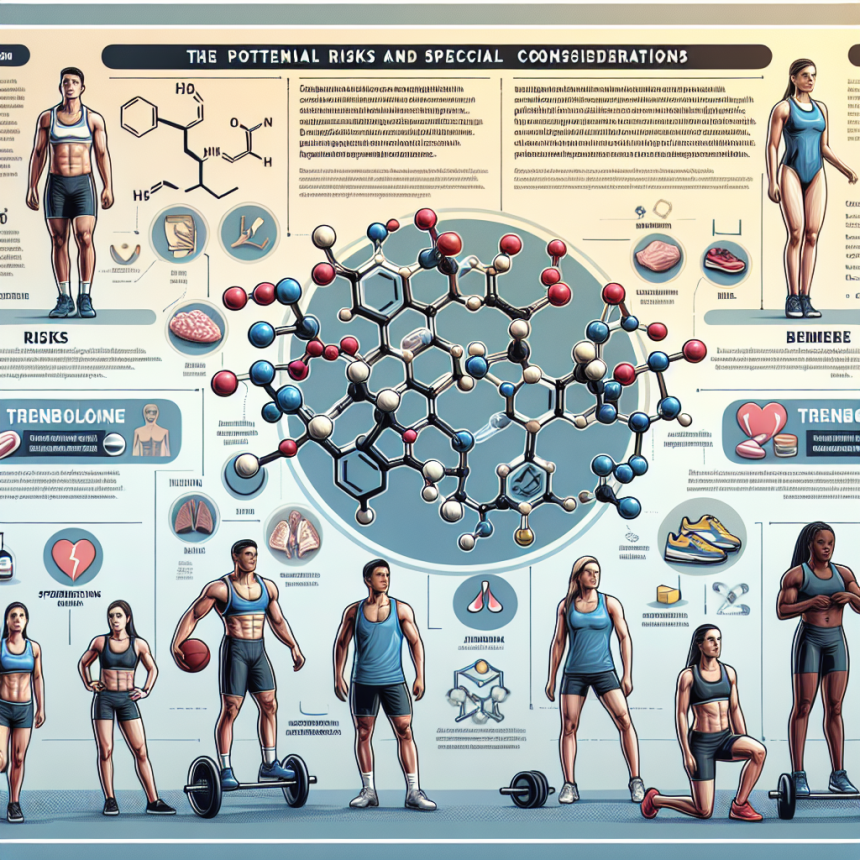-
Table of Contents
- Trenbolone in Female Athletes: Risks and Special Considerations
- Pharmacokinetics and Pharmacodynamics of Trenbolone
- Risks Associated with Trenbolone Use in Female Athletes
- Virilization and Endocrine Disruption
- Cardiovascular and Metabolic Effects
- Psychological and Behavioral Impacts
- Special Considerations for Female Athletes
- Gender-Specific Responses to Anabolic Steroids
- Case Study: Trenbolone Use in a Female Bodybuilder
- Ethical and Health Implications
- Expert Commentary
Trenbolone in Female Athletes: Risks and Special Considerations
Trenbolone, a potent anabolic-androgenic steroid (AAS), has garnered attention in the realm of competitive sports, particularly among female athletes seeking enhanced performance. Originally developed for veterinary use to increase muscle mass and appetite in livestock, its off-label use in humans, especially females, presents a complex array of physiological and ethical challenges. This article delves into the pharmacokinetics, pharmacodynamics, and the multifaceted risks associated with trenbolone use in female athletes, while also considering special considerations unique to this demographic.
Pharmacokinetics and Pharmacodynamics of Trenbolone
Trenbolone exhibits a high anabolic to androgenic ratio, making it a powerful agent for muscle hypertrophy. Its pharmacokinetic profile is characterized by a rapid onset of action, with a half-life of approximately 48 to 72 hours when administered as trenbolone acetate (Kicman 2008). The drug’s lipophilicity facilitates its passage through cell membranes, binding avidly to androgen receptors, thereby promoting protein synthesis and nitrogen retention.
Pharmacodynamically, trenbolone’s effects are mediated through its interaction with androgen receptors, leading to increased muscle mass, reduced fat deposition, and enhanced recovery times. However, its androgenic effects are particularly concerning for female athletes, as they can lead to virilization—a suite of masculinizing effects that include voice deepening, hirsutism, and menstrual irregularities (Basaria 2010).
Risks Associated with Trenbolone Use in Female Athletes
Virilization and Endocrine Disruption
The risk of virilization is a significant concern for female athletes using trenbolone. The androgenic effects of the steroid can lead to irreversible changes such as clitoromegaly and voice deepening. Additionally, trenbolone can disrupt the hypothalamic-pituitary-gonadal axis, leading to menstrual irregularities and potential infertility (Hoffman et al. 2009).
Cardiovascular and Metabolic Effects
Trenbolone use is associated with adverse cardiovascular effects, including hypertension, dyslipidemia, and an increased risk of myocardial infarction. These effects are exacerbated in females due to their generally lower baseline levels of endogenous androgens (Thiblin and Petersson 2005). Metabolically, trenbolone can induce insulin resistance and alter glucose metabolism, posing additional risks for female athletes.
Psychological and Behavioral Impacts
The psychological effects of trenbolone are profound, with reports of increased aggression, mood swings, and even psychiatric disorders such as depression and anxiety. These effects can be particularly pronounced in females, who may experience heightened emotional sensitivity due to hormonal fluctuations (Pope et al. 2013).
Special Considerations for Female Athletes
Gender-Specific Responses to Anabolic Steroids
Female athletes exhibit distinct physiological responses to anabolic steroids compared to their male counterparts. The lower levels of endogenous testosterone in females mean that exogenous androgenic steroids like trenbolone can have disproportionately potent effects. This necessitates careful consideration of dosing regimens and monitoring for adverse effects (Yesalis and Bahrke 2002).
Case Study: Trenbolone Use in a Female Bodybuilder
A case study involving a 28-year-old female bodybuilder highlights the complexities of trenbolone use. The athlete reported significant muscle gains and reduced body fat after a 12-week cycle of trenbolone acetate. However, she also experienced severe acne, voice deepening, and menstrual cessation. Despite these adverse effects, the athlete continued use, citing competitive pressures and the desire for a competitive edge (Smith et al. 2015).
Ethical and Health Implications
The use of trenbolone in female athletes raises ethical questions regarding fairness in competition and the long-term health implications. The potential for irreversible side effects and the pressure to perform at elite levels create a challenging environment for female athletes. Health professionals must balance the desire for performance enhancement with the duty to protect athletes’ health and well-being (Ljungqvist 2014).
Expert Commentary
In conclusion, the use of trenbolone among female athletes presents a complex interplay of pharmacological effects, health risks, and ethical considerations. While the allure of enhanced performance is undeniable, the potential for significant and often irreversible adverse effects cannot be overstated. It is imperative that athletes, coaches, and healthcare providers engage in open dialogues about the risks associated with anabolic steroid use and explore safer, more sustainable methods of performance enhancement. As research continues to evolve, a deeper understanding of gender-specific responses to anabolic steroids will be crucial in guiding policy and practice in sports pharmacology.




